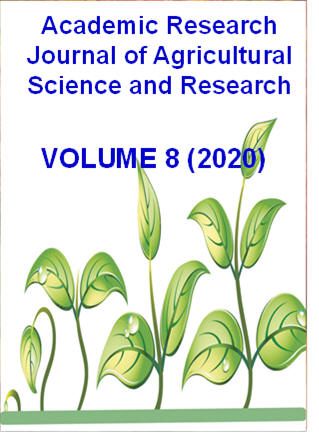|
ISSN: 2360-7874 |
Academic Research Journal of
Agricultural Science and Research |
|||||||||||||||||||
|
Vol. 8(2), pp. 60-69, March 2020 Research Biological and Economic Response of Rice to Nitrogen and Phosphorous fertilizer applications under Rainfed lowland Production Ecology Tilahun Tadesse1*, Zelalem Tadesse2, Habtamu Assega2 and Desta Abaychew2
1Fogera National Rice Research and Training Center, Woreta, Ethiopia *Corresponding author: email-tilahuntadesse2000@gmail.com 2Fogera National Rice Research and Training Center, Woreta, Ethiopia
Accepted 16 March 2020
The national average yield of rice in Ethiopia is about 2.8 t ha-1 which is lower compared to the world average productivity of 4.6 t ha-1. Soil nutrient deficiencies are among the major yield limiting factors of the rice production. In order to recommend appropriate rate of soil nutrients, nitrogen and phosphorous fertilizers application experiment was conducted on rainfed lowland rice production at Fogera plain in two cropping seasons of the years 2016 and 2017. The treatments were comprised of factorial combinations of five nitrogen (0,92,184, 276 and 368 kg ha-1) and four phosphorous levels (0, 23, 46, and 69 P2O5 kg ha-1). Data was collected on plant height, panicle length, number of total tillers/m, number of effective tillers/m, panicle length, number of fertile spiklets/panicle, thousand seeds weight, grain yield, straw yield and harvest index. All collected data were subjected to analysis of variance. Economic analysis was also carried out by following CIMMYT partial budget analysis procedures. The results of the experiment indicated that the main effect of nitrogen application was significantly affecting plant height, panicle length, total tillers/m, effective tillers/m, filled spiklets/panicle, grain yield, straw yield, thousand seeds weight and harvest index while phosphorous was affecting only grain and straw yields. The interaction of nitrogen and phosphorous was affecting grain yield, straw yield and harvest index. With respect to the interaction effect, the highest grain yield (7.0 t ha-1) was obtained at 276-69 N- P2O5 kg ha-1. The economic analysis has exhibited that the combined application of 184-46 N- P2O5 kg ha-1 is the most profitable treatment. It is thus concluded that application of nitrogen and phosphorous fertilizers at rates of 184-46 N- P2O5 kg ha-1 is the best recommended for rainfed lowland rice production in Fogera plain and other similar agroecologies.
Key Words: Lowland rice; Nitrogen; Phosphorous; profitable.
How to cite this article (APA Style): Tilahun T., Zelalem T., Habtamu A., Desta A (2020). Biological and Economic Response of Rice to Nitrogen and Phosphorous fertilizer applications under Rainfed lowland Production Ecology. Acad. Res. J. Agri. Sci. Res. 8(2): 60-69
|
|||||||||||||||||||
